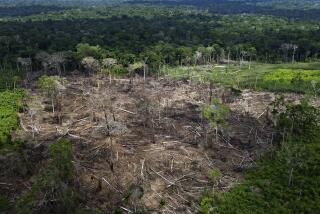Study Rebuts Argument for Cutting Old Trees
- Share via
CORVALLIS, Ore. — A new study appears to contradict claims that cutting down old forests and replacing them with younger trees will benefit Earth’s atmosphere.
Researchers concluded that replacing older trees with young, fast-growing trees will not reduce atmospheric levels of carbon dioxide, a major contributor to the “greenhouse effect” that traps heat close to the Earth’s surface. In fact, they said, computer calculations show that if the old-growth forests are logged, it would take 250 years to return to present levels of carbon dioxide reduction.
Advocates of harvesting old-growth timber contend that logging the older trees and replacing them with younger ones is beneficial to the environment.
“The conventional wisdom was that since young trees remove carbon from the environment more actively than older trees, harvesting the old growth would actually reduce problems with the greenhouse effect,” said Mark Harmon, an Oregon State University researcher and co-author of the study.
But the natural processes are not nearly that simple, Harmon said, and the old theories do not hold up.
“We’ve been concerned that decision-makers are going to be making important policies based on inaccurate, armchair technology,” he said.
The study, published Friday in the journal Science, shows that during the last century, the harvesting of old-growth conifer forests in the Pacific Northwest “has actually injected a disproportionally large amount” of carbon dioxide into the atmosphere, compared to land use changes elsewhere in the world.
Carbon dioxide is considered a primary culprit in the global warming that many scientists believe will occur in the next few decades as heat-trapping “greenhouse” gases increase in the atmosphere.
The rise in carbon dioxide is mainly caused by the burning of fossil fuels, but the cutting of the world’s forests is also being cited for the increased atmospheric concentrations of the gas.
As trees grow, they remove carbon dioxide from the air and incorporate the carbon into their wood and leaves. As long as they live, the carbon stays locked up inside.






